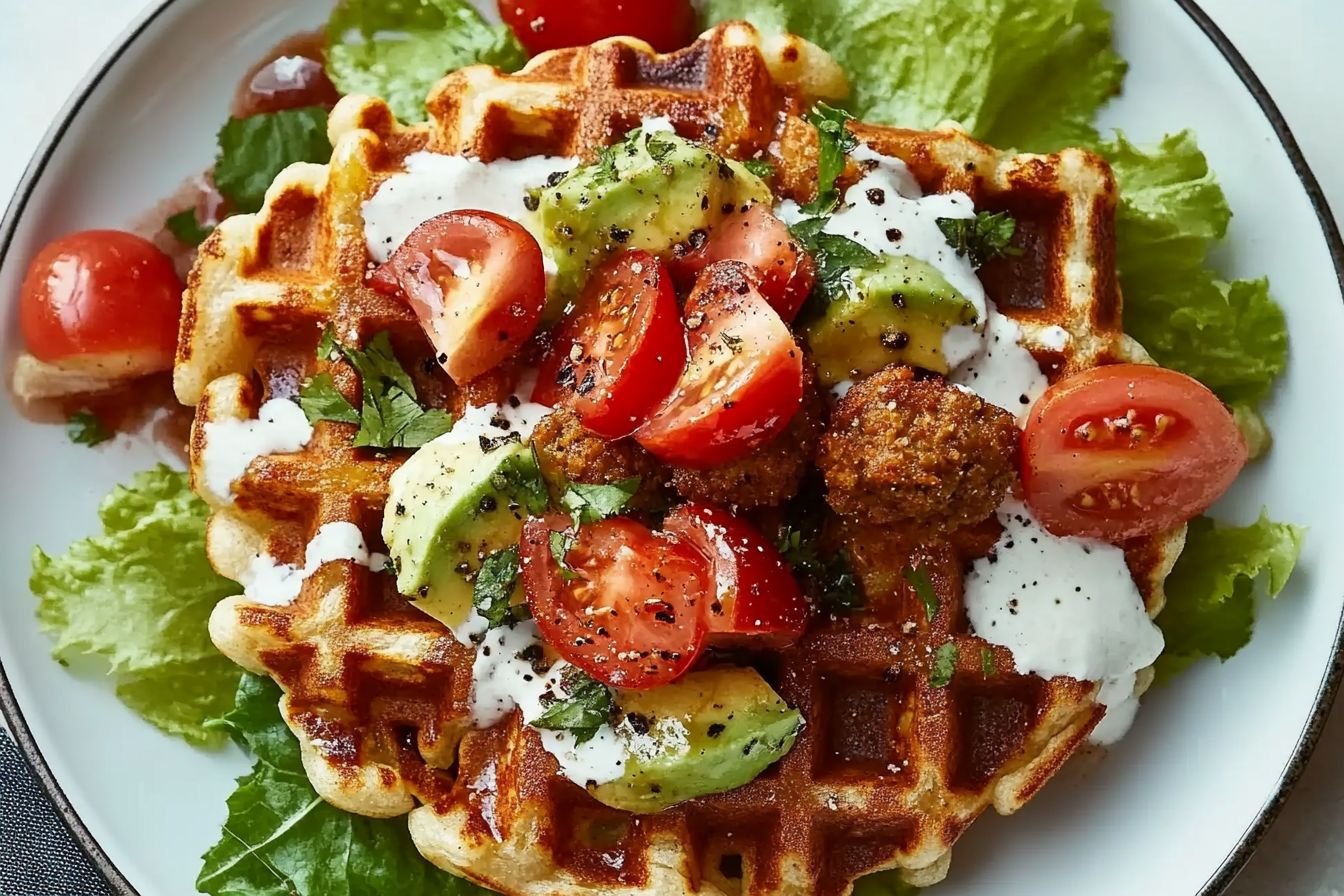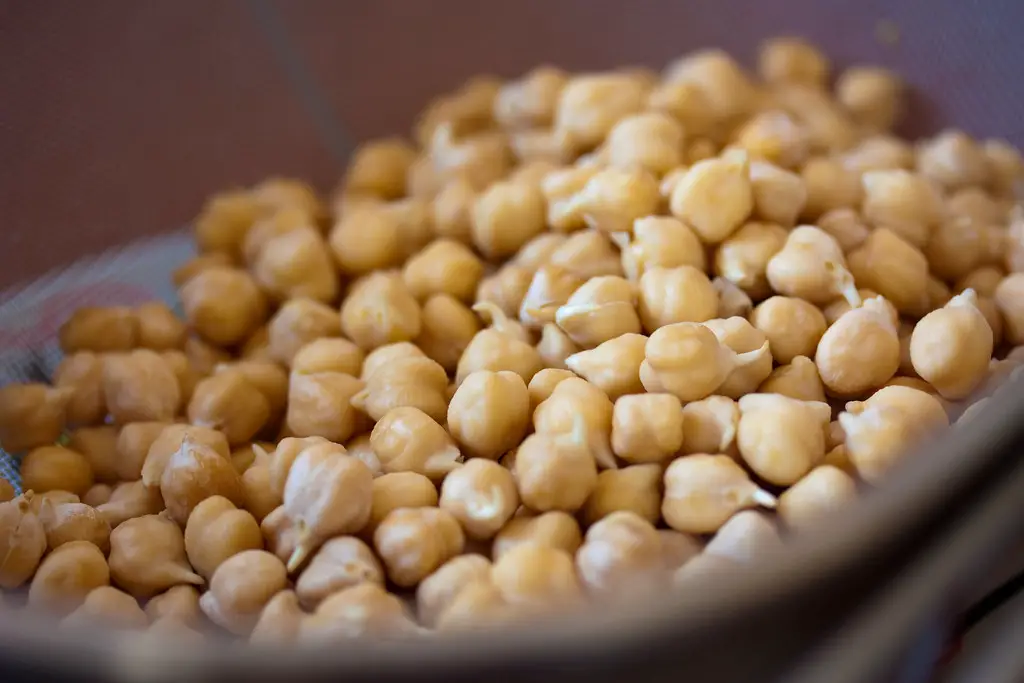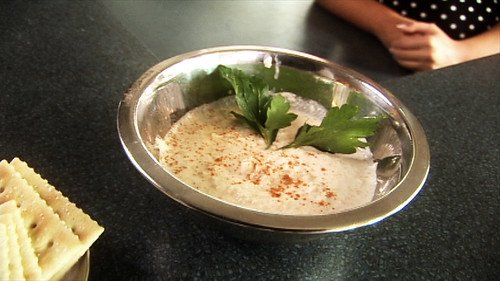Falafel waffle represents an innovative fusion of Middle Eastern tradition and modern cooking techniques, transforming the beloved street food into a crispy, versatile dish that maintains the authentic flavors of falafel while reimagining its form and presentation. This creative twist takes the traditional chickpea or fava bean mixture—typically formed into balls or patties and deep-fried—and adapts it for the waffle iron, creating a dish with a satisfying contrast between a crispy exterior and a tender, herb-infused interior.
This modern interpretation respects the essential elements of traditional falafel—chickpeas, fresh herbs, garlic, cumin, and coriander—while offering a new way to enjoy these classic flavors. With ingredients including chickpeas, fresh parsley, cilantro, garlic, cumin, coriander, and a touch of baking powder for lift, it delivers a satisfying, protein-rich dish that can serve as a versatile base for both traditional Middle Eastern toppings and creative contemporary accompaniments.
History of the Classic Dish
The origins of falafel are somewhat contested, with several countries in the Middle East claiming to be its birthplace. Most food historians believe that falafel originated in Egypt, where was made with fava beans (ful medames) by Coptic Christians as a meat substitute during Lent. This theory is supported by the fact that the word “falafel” may derive from the Arabic word “filfil,” meaning pepper, or from “falāfil,” the plural of “filfila,” which means small round thing.
This fusion also reflects broader trends in contemporary cuisine, where traditional dishes are reimagined to suit modern lifestyles and preferences. It transforms street food typically eaten on the go into a format that works well for sit-down meals, brunches, or even elegant appetizers made in mini waffle makers. It exemplifies how culinary traditions can evolve while maintaining connections to their roots.
These waffles can be seen as part of the ongoing evolution of global cuisine—a respectful borrowing across culinary traditions that creates something new while acknowledging its diverse origins. In this way, it represents not just a delicious dish but a tangible example of cultural exchange and culinary creativity.
Ingredients
- 2 cups of dried chickpeas, soaked overnight (not canned)
- 1 roughly chopped small onion
- 4 cloves of minced garlic
- 1 cup of packed fresh parsley leaves
- 1/2 cup of packed fresh cilantro leaves
- 1 tbsp of ground cumin
- 1 tbsp of ground coriander
- 1 tsp of baking powder
- 1 tsp of salt
- 1/2 tsp of black pepper
- 1/4 tsp of cayenne pepper (optional, for heat)
- 2 tbsp of chickpea flour or all-purpose flour
- 2 tbsp of sesame seeds
- 3 tbsp of olive oil, plus more for the waffle iron
- 2 tbsp of lemon juice
- 1/4 cup water (if needed to adjust consistency)
For serving (optional):
- Tahini sauce (1/2 cup tahini, 2 tbsp of lemon juice, 1 clove minced garlic, salt, and water to thin)
- Diced tomatoes and cucumbers
- Pickled turnips or other pickled vegetables
- Sliced red onion
- Fresh herbs (parsley, mint)
- Sumac for sprinkling
- Hot sauce
- Lemon wedges
How To Make Falafel Waffles?
- Initiate the process by soaking dried chickpeas in water for a minimum of 12 hours or overnight, anticipating a tripling in volume. Avoid canned chickpeas to prevent a mushy outcome.
- Post-soaking, thoroughly drain the chickpeas and pat them dry with paper towels to ensure optimal texture.
- Preheat your waffle iron to medium-high heat, adjusting based on your appliance to achieve a crispy exterior.
- In a food processor, pulse soaked chickpeas, chopped onion, minced garlic, parsley, and cilantro until finely chopped but not pureed, aiming for a coarse, sand-like consistency.
- Transfer the mixture to a bowl and thoroughly combine with cumin, coriander, baking powder, salt, black pepper, and cayenne pepper (if using).
- Incorporate flour, sesame seeds, olive oil, and lemon juice, stirring until well combined. The mixture should hold together with some texture; add minimal water if too dry.
- Allow the mixture to rest for approximately 15-30 minutes to meld flavors and absorb moisture.
- Generously oil the preheated waffle iron to prevent sticking, which is crucial for this mixture.
- Spoon about 1 cup of the falafel mixture onto the center, spreading evenly with a small edge margin.
- Close the waffle iron and cook for approximately 5-7 minutes, or until golden brown and crispy. Check after 5 minutes, as cooking times vary.
- Carefully remove the waffles using non-scratch utensils. It should be crispy outside and moist inside.
- Repeat with the remaining mixture, re-oiling the waffle iron between batches.
- Prepare tahini sauce by whisking tahini, lemon juice, garlic, and salt, gradually adding water to a pourable consistency.
- Serve the waffles traditionally with tahini sauce, diced tomatoes and cucumbers, pickled vegetables, red onion, and herbs, possibly with sumac.
- Alternatively, serve as a base for a Middle Eastern Eggs Benedict.
- Serve whole or quartered as appetizers.
- Refrigerate leftover waffles and reheat in a toaster or oven to maintain crispness.
Nutritional Information
| Nutrient | Amount per serving |
| Calories | 320 |
| Total Fat | 14g |
| Saturated Fat | 1.5g |
| Cholesterol | 0mg |
| Sodium | 480mg |
| Total Carbohydrates | 38g |
| Dietary Fiber | 11g |
| Sugars | 6g |
| Protein | 15g |
Based on a serving size of 1/4 of the recipe, not including toppings or sauces.
Serving and Pairing Suggestions
For a traditional Middle Eastern presentation, serve the falafel waffle as the centerpiece of a mezze-style spread. Cut the waffle into quarters and arrange on a platter surrounded by small bowls of classic accompaniments: tahini sauce, hummus, baba ganoush, tabbouleh, and pickled vegetables. Include a basket of warm pita bread, allowing diners to create their combinations. This interactive serving style honors the communal eating traditions of the Middle East while showcasing the waffle’s unique form.
For a contemporary brunch presentation, serve them as the base for a Middle Eastern-inspired Eggs Benedict. Top with wilted spinach, poached eggs, and a tahini hollandaise sauce (traditional hollandaise with some tahini whisked in). Garnish with a sprinkle of za’atar and chopped fresh herbs. This approach creates an impressive dish that bridges cultures and meal occasions.
They also work beautifully as a base for a build-your-own meal. Set up a toppings bar with various sauces (tahini, tzatziki, harissa), proteins (grilled chicken, roasted lamb, or additional falafel), and fresh and pickled vegetables. This approach is particularly well-suited for family dinners or casual entertaining, allowing each person to customize their meal according to preference.
For a more substantial meal, consider these side dish pairings:
- A simple green salad dressed with lemon and olive oil
- Roasted vegetables seasoned with similar spices (cumin, coriander) for flavor continuity
- A light soup, such as lentil or vegetable, to start the meal
- Rice pilaf with nuts and dried fruits for a heartier accompaniment
For special occasions, consider making mini waffles using a smaller waffle iron. These bite-sized versions make excellent appetizers when topped with a small dollop of tahini sauce and a sprinkle of pomegranate seeds or microgreens. They can be passed on trays for a cocktail party or arranged on a buffet table.
Storing and Reheating
Refrigeration Guidelines:
Falafel waffles can be refrigerated for up to 3-4 days while maintaining good quality. For best results:
- Allow the waffles to cool completely to room temperature before storing. This prevents condensation inside the storage container, which would make the waffles soggy.
- Place the cooled waffles in an airtight container, separating layers with parchment paper to prevent sticking.
- Store any sauces or toppings separately from the waffles to prevent moisture transfer.
- If you’ve made a large batch, consider storing only what you’ll consume within 3-4 days and freezing the rest for longer storage.
Freezing Options:
They freeze surprisingly well, making them excellent for meal prep. To freeze:
- Cool the waffles completely after cooking.
- Place them on a baking sheet lined with parchment paper and freeze until solid (about 2 hours). This initial flash-freezing prevents the waffles from sticking together in storage.
- Once frozen solid, transfer the waffles to a freezer-safe container or heavy-duty freezer bag. If stacking multiple waffles, place parchment paper between them.
- Label the container with the date; frozen waffles maintain best quality for up to 3 months, but remain safe to eat beyond this timeframe.
- For individual portions, consider cutting the waffles into quarters before freezing, allowing you to thaw only what you need.
Reheating Methods:
The key to successfully reheating is restoring their crispy exterior without drying out the interior. Here are the best methods:
Common Mistakes To Avoid
- Using canned chickpeas instead of dried: This is perhaps the most critical mistake to avoid. Canned chickpeas are already cooked, which will result in a mushy texture that won’t hold together properly in the waffle iron. Always start with dried chickpeas that have been soaked but not cooked.
- Over-processing the mixture: Blending the chickpea mixture too finely will create a paste-like consistency that lacks the textural contrast that makes falafel special. Pulse the food processor carefully, aiming for a coarse, sandy texture where small pieces of chickpea are still visible.
- Skipping the resting time: Allowing the mixture to rest for at least 15-30 minutes before cooking is essential. This rest period gives the flour time to absorb moisture and helps the flavors meld together, resulting in a better-tasting waffle that holds its shape.
- Not oiling the waffle iron adequately: The falafel mixture is stickier than traditional waffle batter. Be generous with the oil on both the top and bottom plates of your waffle iron to prevent sticking and ensure easy removal.
- Opening the waffle iron too early: Patience is key when making these waffles. Opening the iron before the waffle has had time to form a crust will likely cause it to split and stick to both plates. Wait at least 3-4 minutes before checking.
- Using too much or too little batter: Finding the right amount of mixture for your specific waffle iron may take some experimentation. Too little won’t fill the iron properly, while too much will overflow and create a mess. Start with about 1 cup for a standard waffle iron and adjust as needed.
- Setting the temperature too high: Unlike traditional waffles that cook quickly at high heat, these waffles need a moderate temperature to cook through without burning. If your waffle iron has adjustable heat, aim for medium to medium-high.
- Not adding enough herbs and spices: The vibrant flavor of falafel comes from generous amounts of fresh herbs and aromatic spices. Don’t be shy with the parsley, cilantro, cumin, and coriander—they’re essential for authentic taste.
- Forgetting to add a leavening agent: The baking powder in the recipe is important for creating some lift in the waffles. Without it, the result may be too dense and heavy.
- Serving with incompatible toppings: While the waffle invites creativity, some toppings may overwhelm its distinctive flavor. Stick to complementary Middle Eastern flavors like tahini, yogurt, fresh vegetables, and herbs rather than heavy, cheese-based toppings that might mask the falafel’s character.
Conclusion
The falafel waffle represents a thoughtful fusion of Middle Eastern culinary tradition and modern cooking techniques, creating a dish that honors its roots while offering a fresh, accessible interpretation. This creative adaptation demonstrates how traditional recipes can evolve to suit contemporary tastes and cooking methods without losing their essential character.
What makes this fusion particularly successful is how it addresses some of the practical challenges of traditional falafel preparation while enhancing its best qualities. The waffle iron creates the crispy exterior that falafel lovers prize, but with more surface area and less oil than deep-frying requires. The grid pattern not only provides visual appeal but also creates perfect pockets for capturing sauces and toppings, enhancing the eating experience. For home cooks who might be intimidated by the prospect of deep-frying or concerned about falafel patties falling apart, the waffle method offers a more foolproof approach.
For home cooks, they provide an opportunity to experiment with Middle Eastern flavors in a format that might feel more familiar and approachable. The basic technique can be customized with different herbs, spices, or even the addition of other legumes, encouraging culinary creativity while maintaining a connection to traditional falafel.
As you’ve read above, the best sauce for falafel is tahini.
Get this homemade tahini recipe now (by clicking the image below):






